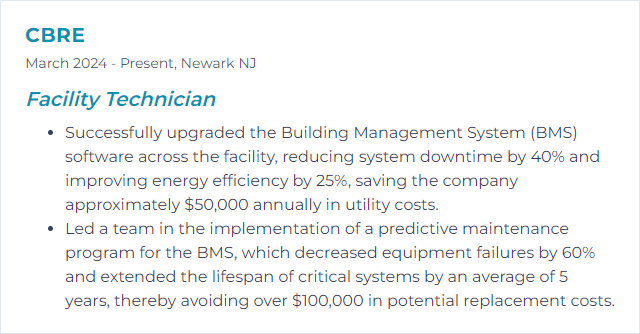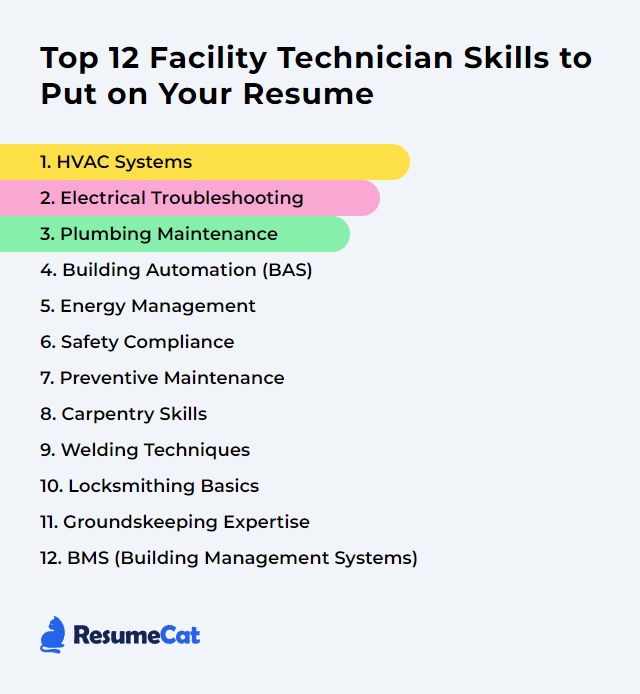Top 12 Facility Technician Skills to Put on Your Resume
In the competitive field of facility maintenance, the right blend of technical know-how and people skills can tilt the odds. A sharp, well-rounded skill set signals you can manage, maintain, and keep the place humming without drama—or downtime.
Facility Technician Skills
- HVAC Systems
- Electrical Troubleshooting
- Plumbing Maintenance
- Building Automation (BAS)
- Energy Management
- Safety Compliance
- Preventive Maintenance
- Carpentry Skills
- Welding Techniques
- Locksmithing Basics
- Groundskeeping Expertise
- BMS (Building Management Systems)
1. HVAC Systems
Heating, Ventilation, and Air Conditioning—climate control that keeps buildings comfortable, healthy, and efficient. For a Facility Technician, that means installing, tuning, repairing, and optimizing every piece from air handlers to thermostats.
Why It's Important
HVAC governs air quality, comfort, and moisture control. It protects equipment and finishes, supports health standards, and drives a big slice of the energy bill—so performance and efficiency matter.
How to Improve HVAC Systems Skills
Boost comfort, trim waste, extend system life. Practical moves that pay off:
Routine maintenance: Clean filters and coils, verify airflow, inspect belts, check refrigerant charge, and seal ducts. Follow recognized standards (e.g., ASHRAE guidance).
High-efficiency upgrades: Swap aging components for efficient models, add VFDs to fans and pumps, and deploy smart/programmable thermostats.
Tighten the envelope: Improve insulation and air sealing around doors, windows, and penetrations to reduce heating and cooling loads.
Zoning and controls: Add zoning, demand-control ventilation, and well-calibrated schedules to serve spaces only when needed.
Energy/heat recovery: Use ERVs/HRVs to bring in fresh air while capturing heating or cooling that would otherwise be lost.
Leverage BAS/BMS: Optimize with trend data, alarms, and analytics. Let the system adjust based on occupancy, weather, and load.
Stay current: Ongoing training and certifications through reputable programs (e.g., HVAC Excellence, RSES) keep skills sharp.
Focus on fundamentals and smart control. Efficiency follows.
How to Display HVAC Systems Skills on Your Resume
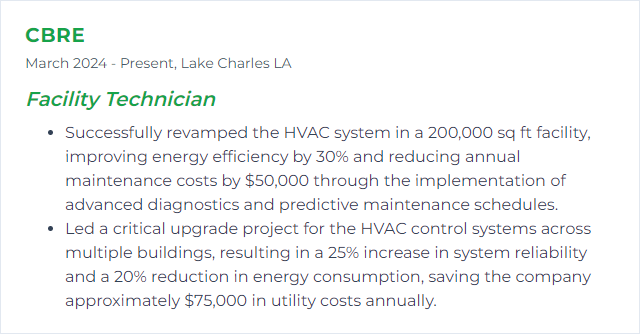
2. Electrical Troubleshooting
Methodical diagnosis of electrical issues in equipment and building systems. Track faults, verify circuits, fix root causes—safely and cleanly.
Why It's Important
It prevents hazards, cuts downtime, and curbs repair costs. In short, it keeps operations steady and people safe.
How to Improve Electrical Troubleshooting Skills
Master the basics: Voltage, current, resistance, power, and how circuits behave. Without this, everything feels like guesswork.
Read schematics: Wiring diagrams, one-lines, and control drawings—learn notation, tracing, and signal flow.
Use the right tools: Multimeters, clamp meters, non-contact testers, circuit tracers, and insulated tools—know when and how to use each.
Practice—often: Build small test circuits or use simulators to sharpen logic and speed.
Safety above all: Lockout/tagout, arc-flash awareness, PPE, and NFPA 70E practices. No shortcuts.
Keep learning: Workshops and courses through reputable bodies (IEEE, NFPA) help you stay current.
Confidence comes from repetition and disciplined process.
How to Display Electrical Troubleshooting Skills on Your Resume
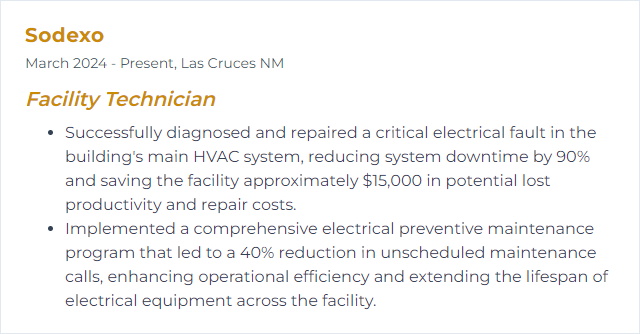
3. Plumbing Maintenance
Inspection, cleaning, and repair of piping, fixtures, valves, and heaters to keep water flowing the right way—without surprises.
Why It's Important
It prevents leaks and blockages, protects finishes and equipment, maintains water quality, and avoids costly emergencies.
How to Improve Plumbing Maintenance Skills
Proactive inspections: Look for corrosion, slow leaks, discoloration, and worn seals. Compare meter readings to spot hidden losses.
Protect drains: Use strainers, schedule periodic cleaning, and discourage grease or non-degradables from entering the system.
Manage pressure: Verify static and dynamic pressure, set PRVs appropriately, and watch for pressure spikes.
Care for water heaters: Flush sediment, test T&P valves, check anode rods, and insulate piping.
Winterize wisely: Insulate exposed lines, heat-trace where needed, and drain seasonal piping.
Educate occupants: Clear guidance on what not to flush or pour, and how to report issues fast.
Small habits prevent big headaches.
How to Display Plumbing Maintenance Skills on Your Resume
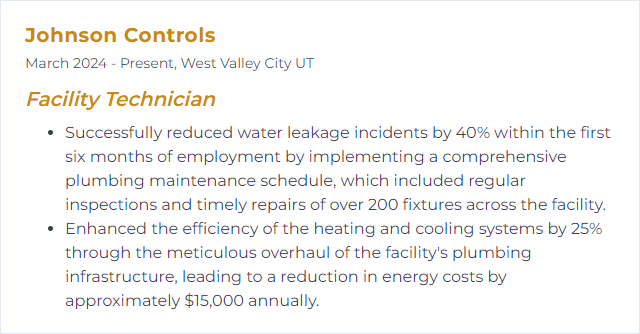
4. Building Automation (BAS)
Software and hardware that orchestrate HVAC, lighting, life safety, and security. One pane of glass; many moving parts.
Why It's Important
BAS streamlines operations, lifts comfort, cuts energy, and flags problems early. Less chasing alarms, more solving root causes.
How to Improve Building Automation (BAS) Skills
Keep software current: Apply updates and patches to add features, improve stability, and tighten security.
Use predictive strategies: Trend key points, set meaningful alarms, and act before failures cascade.
Integrate sensors and IoT: Add granular data—temperature, CO2, occupancy, vibration—to refine control logic.
Train the team: Document standards, build SOPs, and ensure operators can navigate graphics, schedules, and overrides.
Harden cybersecurity: Segment networks, enforce strong authentication, and audit access regularly.
Optimize for energy: Tighten schedules, reset setpoints seasonally, enable economizers, and use demand limiting where appropriate.
Audit regularly: Verify sequences, tune PID loops, and fix bad or stale points with periodic point-to-point checks.
Good data plus clear sequences equals smooth buildings.
How to Display Building Automation (BAS) Skills on Your Resume

5. Energy Management
Monitoring, controlling, and reducing energy use without sacrificing performance. Smart choices, measured results.
Why It's Important
It lowers operating costs, supports sustainability goals, and extends system life—while keeping occupants comfortable.
How to Improve Energy Management Skills
Benchmark and monitor: Establish baselines, track interval data, and use an EMS to spot drift and anomalies. ENERGY STAR tools are helpful references.
Light smarter: Convert to LED, add occupancy and daylight sensors, and tune light levels to the task.
Tune HVAC: Maintain coils and filters, verify economizers, deploy VFDs, and use programmable/smart thermostats. Follow established performance standards.
Add renewables where viable: Evaluate solar PV and consider storage if it pencils out with demand charges.
Engage occupants: Clear policies for equipment shutoff, thermostat discipline, and efficient space use.
Maintain and replace: Keep equipment in spec and plan right-timed upgrades to high-efficiency models.
Buy efficiently: Favor ENERGY STAR or FEMP-aligned products when procuring.
Measure, adjust, repeat—the savings stick.
How to Display Energy Management Skills on Your Resume

6. Safety Compliance
Consistent adherence to health, safety, and environmental rules so work gets done without harm.
Why It's Important
It protects people, preserves assets, and keeps the organization on the right side of regulations. A non-negotiable baseline.
How to Improve Safety Compliance Skills
Train routinely: LOTO, hazard communication, NFPA 70E, first aid/CPR, and job-specific hazards—refreshers included.
Inspect and maintain: Scheduled checks on tools, guards, ladders, lifts, and emergency systems to prevent failures.
Follow and document: Clear SOPs, permits where required, and records that show the work was done right.
Use proper PPE: Match gear to the task and enforce consistent use.
Report and learn: Simple incident and near-miss reporting, with root-cause analysis and corrective actions.
Culture matters. Lead by example.
How to Display Safety Compliance Skills on Your Resume
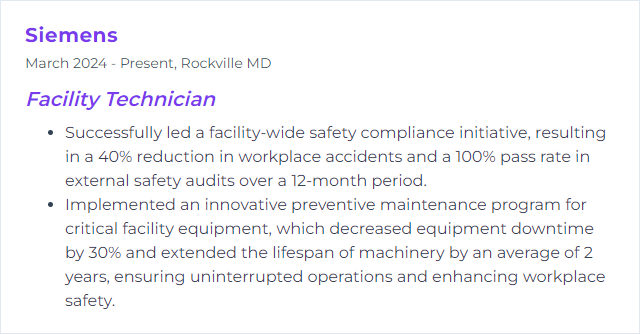
7. Preventive Maintenance
Planned, recurring maintenance that keeps assets reliable. Fix the small things before they become big outages.
Why It's Important
It reduces breakdowns, lowers lifecycle costs, and stretches asset life—while keeping operations steady and safe.
How to Improve Preventive Maintenance Skills
Prioritize by criticality: Rank assets by risk and impact, then plan intervals that make sense.
Use a CMMS/EAM: Automate schedules, track work orders, store history, and mine the data.
Layer in predictive: Vibration, thermography, ultrasound, and oil analysis to catch early signs of trouble.
Standardize tasks: Clear SOPs, torque specs, checklists, and acceptance criteria.
Train continuously: New tech, new tools, better methods—keep the team sharp. FacilitiesNet and similar sources are useful references.
Review and refine: Watch KPIs (MTBF, PM compliance, downtime). Adjust frequencies and scopes as data dictates.
Discipline today, fewer emergencies tomorrow.
How to Display Preventive Maintenance Skills on Your Resume
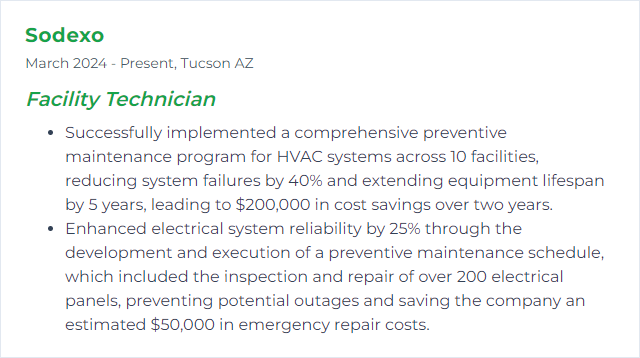
8. Carpentry Skills
Measure, cut, fasten, finish. Repair and build structures, fixtures, and finishes that hold up to use and time.
Why It's Important
Carpentry keeps spaces safe, functional, and presentable. It solves problems quickly and cost-effectively, often on the first pass.
How to Improve Carpentry Skills
Practice deliberately: Tackle varied projects to build accuracy, speed, and judgment.
Learn from pros: Video tutorials and structured courses can shortcut years of trial and error.
Know tools and materials: Species, fasteners, adhesives, finishes—plus maintenance and safe setups.
Work safely: Guards on, blades sharp, dust control, and the right PPE.
Join a community: Forums and groups (including r/carpentry) offer critiques, tricks, and fresh ideas.
Read widely: Books and trade magazines deepen technique and design sense.
How to Display Carpentry Skills on Your Resume

9. Welding Techniques
Joining metal with control and confidence. Common approaches include:
MIG (GMAW): Wire-fed, fast, and versatile. Great for general repairs.
TIG (GTAW): Precise, clean welds with excellent control—ideal for thin or intricate work.
Stick (SMAW): Forgiving on rusty or outdoor jobs. Field-friendly and robust.
Flux-cored (FCAW): Similar to MIG, better in wind and on thicker materials.
Each method demands proper setup, prep, and respect for safety.
Why It's Important
Sound welds preserve structural integrity, restore damaged components, and fabricate solutions fast—minimizing downtime.
How to Improve Welding Techniques
Lock in fundamentals: Process selection, metallurgy basics, joint design, and safety protocols.
Handle gear correctly: Choose the right machine and consumables, set parameters, and maintain equipment. Manufacturer guides are invaluable.
Practice with purpose: Repetition builds steadiness and consistency. Track settings and results.
Seek feedback: Mentors and communities (e.g., WeldingWeb) can spot issues you miss.
Stay current: Follow trade publications like The Fabricator for new techniques and tools.
Train and certify: Workshops and AWS-aligned certifications validate skills and open doors.
Clean prep, right process, steady hand—that’s the recipe.
How to Display Welding Techniques Skills on Your Resume
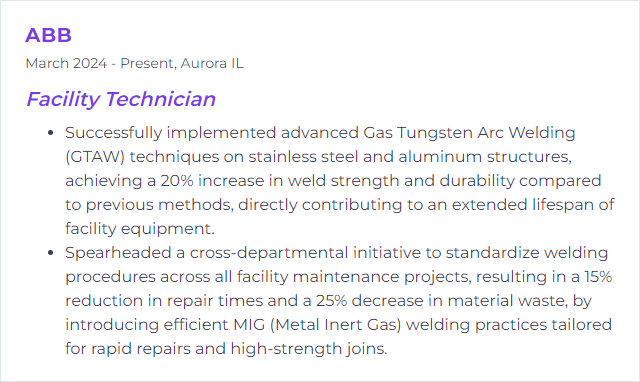
10. Locksmithing Basics
Install, maintain, and repair mechanical and electronic locks. Rekey, duplicate keys, manage master systems, and support access control.
Why It's Important
Fast, competent lock work protects people and property. It resolves lockouts, tightens security, and keeps traffic moving.
How to Improve Locksmithing Basics Skills
Learn mechanisms: Pin tumbler, wafer, disc detainer—understand how each design works and fails.
Practice bypass skills: Use training locks and proper tools to develop finesse without damage.
Get fluent in keys: Duplication, decoding, and rekeying—plus safe use of key cutting machines.
Explore smart locks: Install and troubleshoot electronic locks and access control systems.
Join associations: Groups like ALOA offer education, standards, and certifications.
Keep studying: Trade publications (e.g., The National Locksmith) help you track evolving tech.
Security is a moving target—so keep moving with it.
How to Display Locksmithing Basics Skills on Your Resume
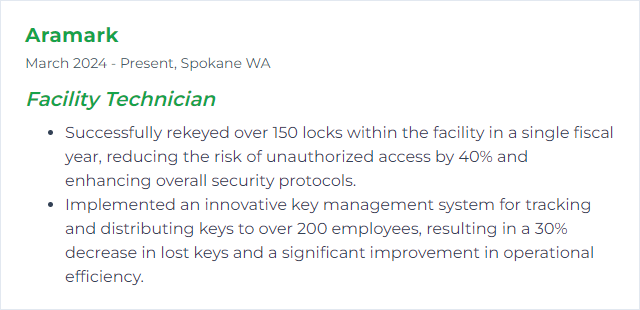
11. Groundskeeping Expertise
Care and upkeep of outdoor spaces—lawns, beds, trees, irrigation, hardscapes—so the exterior looks sharp and stays safe.
Why It's Important
It protects curb appeal, ensures safe access, and supports property value. The outside tells a story before anyone steps in.
How to Improve Groundskeeping Expertise Skills
Study the craft: Horticulture or landscape courses build plant, soil, and irrigation knowledge.
Earn credentials: Certifications like PGMS Certified Grounds Manager boost credibility.
Attend workshops: Hands-on sessions with local horticulture groups sharpen technique.
Network: Professional groups and online communities share practices that work.
Experiment: Test sustainable practices, seasonal plantings, and efficient maintenance routines.
Request feedback: Walk the site with peers or supervisors and adjust based on observations.
Healthy landscapes are designed, not lucked into.
How to Display Groundskeeping Expertise Skills on Your Resume

12. BMS (Building Management Systems)
A centralized platform to monitor and control building systems—ventilation, lighting, power, fire, and security—for reliability, comfort, and efficiency.
Why It's Important
BMS simplifies operations, improves energy performance, and speeds troubleshooting. A force multiplier for any facilities team.
How to Improve BMS (Building Management Systems) Skills
Tune core settings: Schedules, setpoints, resets, and demand limits aligned to occupancy and seasons.
Add sensors strategically: Occupancy, CO2, temperature, and power metering unlock better control.
Keep software updated: New features and security patches matter—apply them routinely.
Drive efficiency: LEDs, occupancy sensors, and efficient HVAC strategies mesh well with BMS control.
Invest in training: Courses and credible content providers build operator confidence and consistency.
Audit systems: Periodic graphics reviews, point verification, and sequence checks catch drift.
Use analytics/AI: Fault detection, optimization, and comfort scoring highlight where to act first.
Secure the network: Segment controls, harden endpoints, monitor traffic, and enforce MFA.
When points are clean and sequences clear, the building behaves.
How to Display BMS (Building Management Systems) Skills on Your Resume
